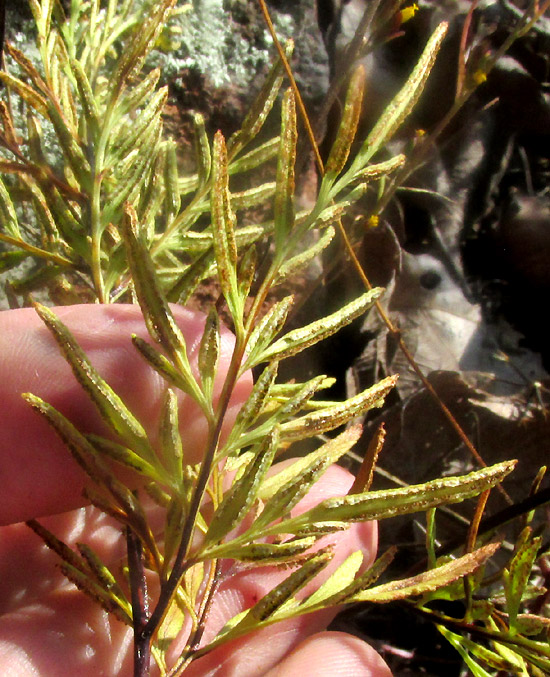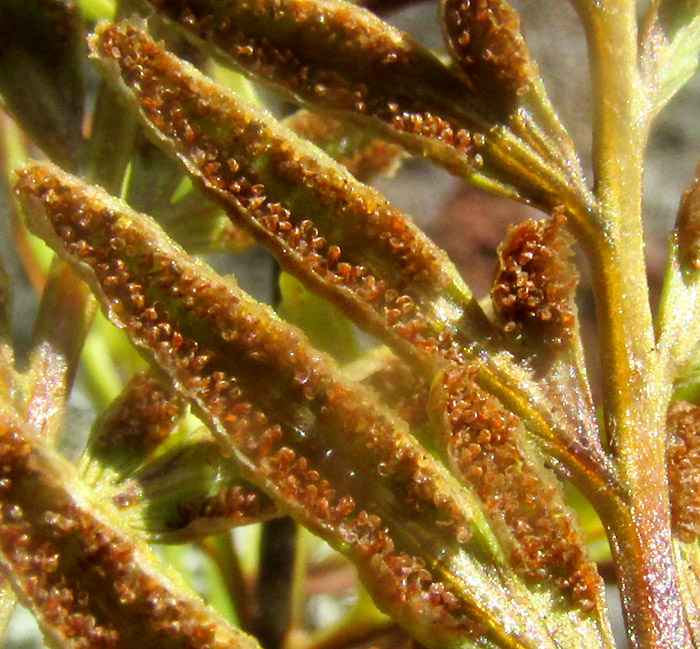Excerpts from Jim Conrad's
Naturalist Newsletter
Entry dated November 7, 2023, from notes taken at Cascadas de La Piedad waterfall 3kms NW of the community of San Pablo, municipality of Almeaco de Bonfil; bedrock of igneous andesite; N20.1003°, W100.0026°, elevation 2360 meters (7750ft); extreme southern Querétaro state, MÉXICO
PTERIS {MILDELLA} FALLAX

On a steep slope of a narrow, moist, usually shaded, erosional gully about 300m northeast of the Cascada de La Piedad, or Piety Waterfall, at the base of an andesite rock, the above fern looked like it may have been suffering from the ongoing two-year dry period classified by the North American Drought Monitor as an extreme D3 drought; brown, dried-out fronds clustered all around its base.

The frond's petioles, rachises and costas were purplish black, though the midribs and veins of the ultimate leaflets, or pinnules, were greenish. The frond was pinnately 1-2 times divided. The fronds' undersurfaces produced plenty of granular, brown sporangia.


Note how the sporangia are produced inside the pinnules' curved-under margins. This indicates the big fern family Pteridaceae. Also notice that the underturned margin edges are curvy, very thin, or scarious, and in some places develop very low teeth. At the right, white splotches on the dark rachis's right side appear to lie in a very shallow channel in the costa. The species is described as having very short hairs in "canals" in the petiole, and maybe that's what they're talking about. Also, notice that the greenish blade margins tend to descend down the costae as narrow wings, even entering onto the rachis.
These are obscure details, but the are important field marks because this fern is very similar to several other taxa occurring in this area.
Based on the above observations, the 2019 Flora del Bajío, which includes plants from Querétaro state, leads us to Mildella fallax, which matches our pictures. Currently, Kew's Plants of the World Online database lists this name as PTERIS FALLAX. Not only that, but Kew says "This name is unplaced." They define unplaced names as "... names that cannot be accepted, nor can they be put into synonymy."
In other words, it seems that our plant doesn't belong to the small genus Mildella, but it's unclear where it does belong, though the genus Pteris probably is a more appropriate home than Mildella. On the other hand, the authoritative GBIF database says it's the other way around: Pteris fallax is a synonym for Mildella fallax. Just to be consistent, I'm using Kew's decision.
Whatever our fern "really is," the species occurs throughout Mexico's rocky highland areas into Guatemala.
I find no mention of human uses for our fern, possibly because, unless you're interested in taxonomy, this taxon is so similar to others that most people simply don't recognize its existence as something different, and don't write about it.